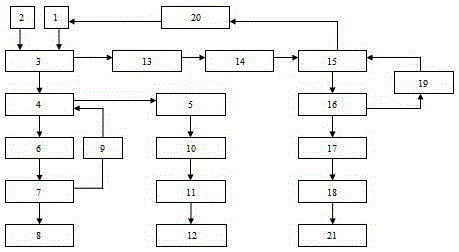Resource utilization method of waste hydrochloric acid containing heavy metal lead and iron
A waste hydrochloric acid and heavy metal technology, applied in chemical instruments and methods, separation methods, water/sludge/sewage treatment, etc., can solve the problems of large amount of concentrated sulfuric acid and high energy consumption, and achieve excellent purification performance
- Summary
- Abstract
- Description
- Claims
- Application Information
AI Technical Summary
Problems solved by technology
Method used
Image
Examples
Embodiment 1
[0023] see figure 1 , put 2000L waste hydrochloric acid (the mass concentration of hydrochloric acid is 15%, the mass concentration of lead ion is 1500ppm, and the mass concentration of iron ion is 8.9%) into lead removal reaction tank 3, and gradually add 250L of sodium sulfide solution with a mass concentration of 18% 1 and 18L mass concentration is 5% sodium phosphate solution 2, continue to stir and react for 30 minutes after the dropwise addition is completed, discharge to the static precipitation tank 4, stand for 1.5 hours, then pump the supernatant into the ferric chloride solution for storage The tank 5 and the sedimentation tank bottom mud 6 are filtered through the plate and frame filter press 7 to obtain the lead sulfide mud cake 8, and the plate and frame filtrate 9 is pumped into the settling tank 4.
[0024] (1) Preparation of polymerized ferric chloride flocculant: pass the ferric chloride solution through the bag filter 10 to remove fine suspended matter, ente...
Embodiment 2
[0027] see figure 1 , 2000L waste hydrochloric acid (the mass concentration of hydrochloric acid is 3%, the mass concentration of lead ion is 300ppm, the mass concentration of iron ion is 9.5%) is added in the deleading reaction tank 3, and 250L mass concentration is 10% vulcanization Potassium solution 1 and 10L mass concentration are 5% potassium dihydrogen phosphate solution 2, after dropwise addition, continue to stir and react for 50 minutes, discharge to static precipitation tank 4, stand for 3 hours, then pump the supernatant into chlorine The iron solution storage tank 5 and the bottom sludge 6 of the sedimentation tank are filtered by a plate and frame filter press 7 to obtain a lead sulfide mud cake 8, and the plate and frame filtrate 9 is pumped into the static sedimentation tank 4.
[0028] (1) Preparation of polymerized ferric chloride flocculant: pass the ferric chloride solution through the bag filter 10 to remove fine suspended matter, enter the flocculant reac...
Embodiment 3
[0030] Example 3: Example of use
[0031] The polyferric chloride flocculant prepared in Example 1 was used for domestic sewage treatment. at 1m 3 Add 1.8kg polymerized ferric chloride flocculant to the domestic sewage, stir for 10 minutes, let it settle for 60 minutes, and take samples to test the treatment effect of domestic sewage. Before treatment, domestic sewage turbidity 266NTU, COD Cr 560.8mg / L, ammonia nitrogen 31.9mg / L, total phosphorus 3.2mg / L, after treatment with polyferric chloride flocculant, turbidity decreased by 95.8%, COD Cr , ammonia nitrogen and total phosphorus removal rates were 79.5%, 81.9% and 82.9%.
PUM
 Login to View More
Login to View More Abstract
Description
Claims
Application Information
 Login to View More
Login to View More - R&D
- Intellectual Property
- Life Sciences
- Materials
- Tech Scout
- Unparalleled Data Quality
- Higher Quality Content
- 60% Fewer Hallucinations
Browse by: Latest US Patents, China's latest patents, Technical Efficacy Thesaurus, Application Domain, Technology Topic, Popular Technical Reports.
© 2025 PatSnap. All rights reserved.Legal|Privacy policy|Modern Slavery Act Transparency Statement|Sitemap|About US| Contact US: help@patsnap.com

